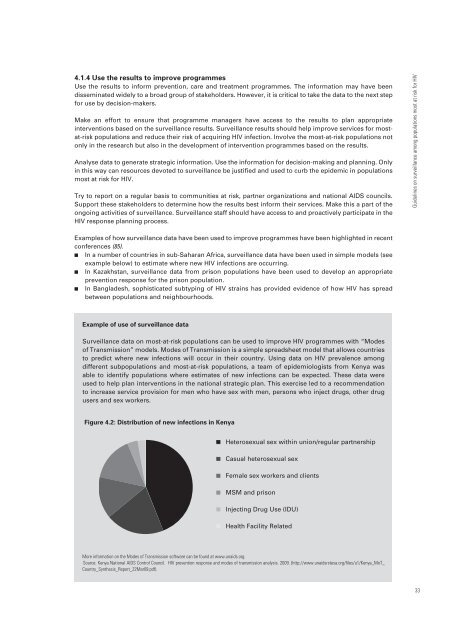Guidelines on surveillance among populations most at risk for HIV
Guidelines on surveillance among populations most at risk for HIV
Guidelines on surveillance among populations most at risk for HIV
- No tags were found...
You also want an ePaper? Increase the reach of your titles
YUMPU automatically turns print PDFs into web optimized ePapers that Google loves.
4.1.4 Use the results to improve programmesUse the results to in<strong>for</strong>m preventi<strong>on</strong>, care and tre<strong>at</strong>ment programmes. The in<strong>for</strong>m<strong>at</strong>i<strong>on</strong> may have beendissemin<strong>at</strong>ed widely to a broad group of stakeholders. However, it is critical to take the d<strong>at</strong>a to the next step<strong>for</strong> use by decisi<strong>on</strong>-makers.Make an ef<strong>for</strong>t to ensure th<strong>at</strong> programme managers have access to the results to plan appropri<strong>at</strong>einterventi<strong>on</strong>s based <strong>on</strong> the <strong>surveillance</strong> results. Surveillance results should help improve services <strong>for</strong> <strong>most</strong><strong>at</strong>-<strong>risk</strong>popul<strong>at</strong>i<strong>on</strong>s and reduce their <strong>risk</strong> of acquiring <strong>HIV</strong> infecti<strong>on</strong>. Involve the <strong>most</strong>-<strong>at</strong>-<strong>risk</strong> popul<strong>at</strong>i<strong>on</strong>s not<strong>on</strong>ly in the research but also in the development of interventi<strong>on</strong> programmes based <strong>on</strong> the results.Analyse d<strong>at</strong>a to gener<strong>at</strong>e str<strong>at</strong>egic in<strong>for</strong>m<strong>at</strong>i<strong>on</strong>. Use the in<strong>for</strong>m<strong>at</strong>i<strong>on</strong> <strong>for</strong> decisi<strong>on</strong>-making and planning. Onlyin this way can resources devoted to <strong>surveillance</strong> be justified and used to curb the epidemic in popul<strong>at</strong>i<strong>on</strong>s<strong>most</strong> <strong>at</strong> <strong>risk</strong> <strong>for</strong> <strong>HIV</strong>.Try to report <strong>on</strong> a regular basis to communities <strong>at</strong> <strong>risk</strong>, partner organiz<strong>at</strong>i<strong>on</strong>s and n<strong>at</strong>i<strong>on</strong>al AIDS councils.Support these stakeholders to determine how the results best in<strong>for</strong>m their services. Make this a part of the<strong>on</strong>going activities of <strong>surveillance</strong>. Surveillance staff should have access to and proactively particip<strong>at</strong>e in the<strong>HIV</strong> resp<strong>on</strong>se planning process.<str<strong>on</strong>g>Guidelines</str<strong>on</strong>g> <strong>on</strong> <strong>surveillance</strong> am<strong>on</strong>g popul<strong>at</strong>i<strong>on</strong>s <strong>most</strong> <strong>at</strong> <strong>risk</strong> <strong>for</strong> <strong>HIV</strong>Examples of how <strong>surveillance</strong> d<strong>at</strong>a have been used to improve programmes have been highlighted in recentc<strong>on</strong>ferences (85). In a number of countries in sub-Saharan Africa, <strong>surveillance</strong> d<strong>at</strong>a have been used in simple models (seeexample below) to estim<strong>at</strong>e where new <strong>HIV</strong> infecti<strong>on</strong>s are occurring. In Kazakhstan, <strong>surveillance</strong> d<strong>at</strong>a from pris<strong>on</strong> popul<strong>at</strong>i<strong>on</strong>s have been used to develop an appropri<strong>at</strong>epreventi<strong>on</strong> resp<strong>on</strong>se <strong>for</strong> the pris<strong>on</strong> popul<strong>at</strong>i<strong>on</strong>. In Bangladesh, sophistic<strong>at</strong>ed subtyping of <strong>HIV</strong> strains has provided evidence of how <strong>HIV</strong> has spreadbetween popul<strong>at</strong>i<strong>on</strong>s and neighbourhoods.Example of use of <strong>surveillance</strong> d<strong>at</strong>aSurveillance d<strong>at</strong>a <strong>on</strong> <strong>most</strong>-<strong>at</strong>-<strong>risk</strong> popul<strong>at</strong>i<strong>on</strong>s can be used to improve <strong>HIV</strong> programmes with “Modesof Transmissi<strong>on</strong>” models. Modes of Transmissi<strong>on</strong> is a simple spreadsheet model th<strong>at</strong> allows countriesto predict where new infecti<strong>on</strong>s will occur in their country. Using d<strong>at</strong>a <strong>on</strong> <strong>HIV</strong> prevalence am<strong>on</strong>gdifferent subpopul<strong>at</strong>i<strong>on</strong>s and <strong>most</strong>-<strong>at</strong>-<strong>risk</strong> popul<strong>at</strong>i<strong>on</strong>s, a team of epidemiologists from Kenya wasable to identify popul<strong>at</strong>i<strong>on</strong>s where estim<strong>at</strong>es of new infecti<strong>on</strong>s can be expected. These d<strong>at</strong>a wereused to help plan interventi<strong>on</strong>s in the n<strong>at</strong>i<strong>on</strong>al str<strong>at</strong>egic plan. This exercise led to a recommend<strong>at</strong>i<strong>on</strong>to increase service provisi<strong>on</strong> <strong>for</strong> men who have sex with men, pers<strong>on</strong>s who inject drugs, other drugusers and sex workers.Figure 4.2: Distributi<strong>on</strong> of new infecti<strong>on</strong>s in KenyaHeterosexual sex within uni<strong>on</strong>/regular partnershipCasual heterosexual sexFemale sex workers and clientsMSM and pris<strong>on</strong>Injecting Drug Use (IDU)Health Facility Rel<strong>at</strong>edMore in<strong>for</strong>m<strong>at</strong>i<strong>on</strong> <strong>on</strong> the Modes of Transmissi<strong>on</strong> software can be found <strong>at</strong> www.unaids.org.Source: Kenya N<strong>at</strong>i<strong>on</strong>al AIDS C<strong>on</strong>trol Council. <strong>HIV</strong> preventi<strong>on</strong> resp<strong>on</strong>se and modes of transmissi<strong>on</strong> analysis. 2009. (http://www.unaidsrstesa.org/fi les/u1/Kenya_MoT_Country_Synthesis_Report_22Mar09.pdf).33















